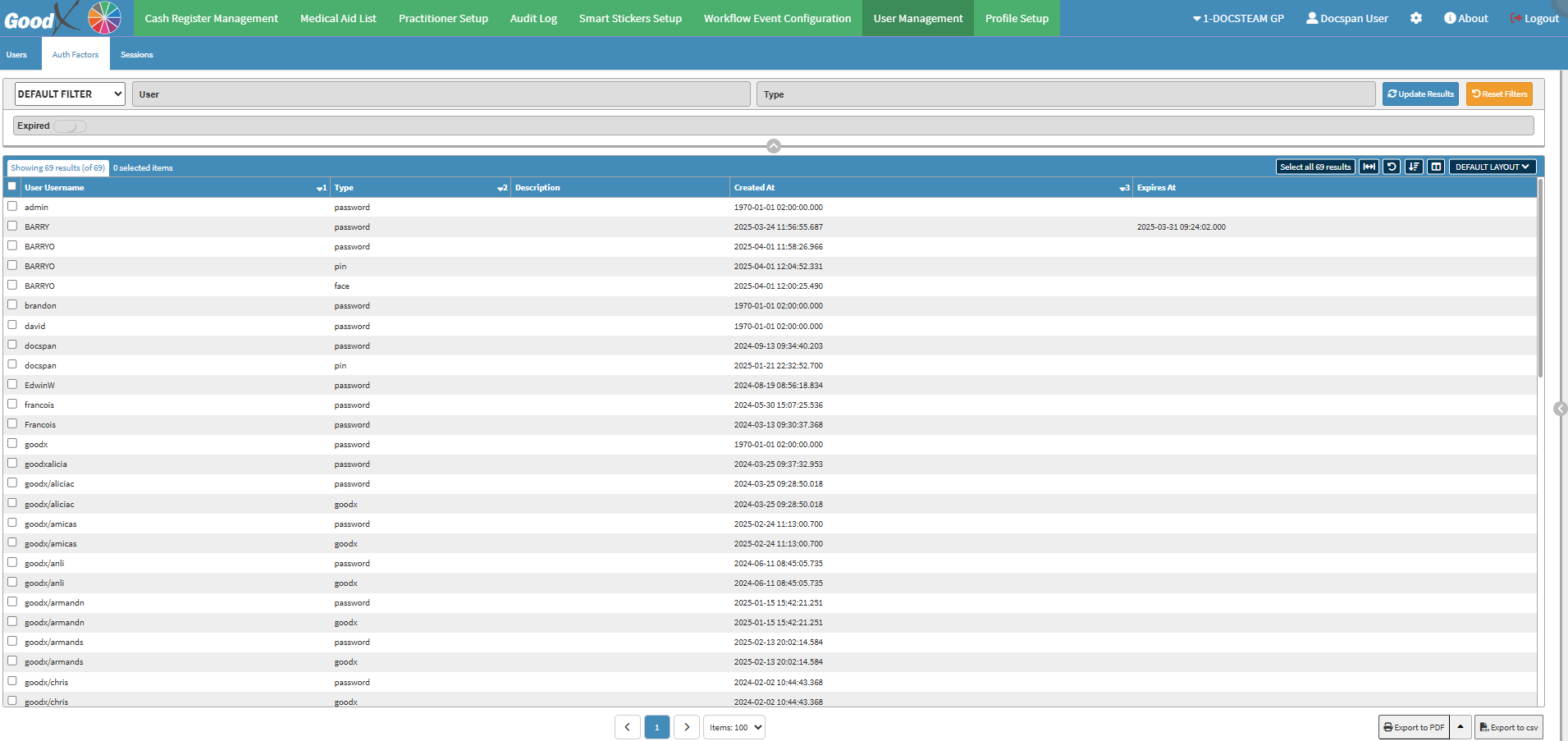Authentication Factors: Navigation and Use
Why Use This Function:
The Authentication Factors tab enhances security by managing the authentication settings for various GoodX features requiring a password or pin. By configuring these factors, you can ensure that only authorised individuals gain access, reducing the risk of unauthorised entry. This feature allows for flexible authentication options, improving both security and User convenience. Keeping authentication factors up to date helps maintain a secure environment while ensuring seamless access for authorised Users.
The Contents of This User Manual:
- Filters
- Screen Columns Action Buttons
- Columns
- Sidebar
- Page Options
- This user manual will start on the User Management tab, Auth Factors screen.

- For more information on how to navigate to the User Management tab, please refer to the user manual: Configuration Segment.
Filters
Allows you to narrow down or refine the results displayed on the Authentication Factors tab.- Click on the Default Filter drop-down menu to select how the screen will be filtered.

- Click on the User field to enter the name of the User or select the User from the options that become available when you start typing.

💡Please Note: The Users available will depend on the setup for the Practice.
- Click on the Types drop-down menu to select the Authentication Type you are searching for from the list that has become available.

💡Please Note: The authentication types will depend on the setup for the Practice.
- The Expired slider is automatically set to show all the Users.
![]()
- Click on the Expired slider to show Users that have not been expired.
![]()
- Click on the Expired slider a second time to show Users that have expired.
![]()
- Click on the Update Results button to refresh the list after the Filters have been selected.
![]()
- Click on the Reset Filters button to clear the Filters that have been set.
![]()
Screen Columns Action Buttons
Several additional Options are available for the Columns. These additional Options are to help you adjust the screen, refine the Search and give more specific results.
- Click on the Select All Results button to select all the results currently displayed on the screen.
![]()
- Click on the Expand Widths button to auto-fit the column width to the information within all columns.
![]()
- Click on the Reset Widths button to restore the original Widths after any modifications are done.
![]()
- Click on the Sort Columns button to sort the Columns in the order that you desire.
![]()
- For more information regarding how the Sort Columns feature works, please refer to the user manual: How to Sort Columns on Reports and List Screens.
- Click on the Choose Columns button to select the columns that will be displayed on the list.
![]()
- For more information regarding how the Choose Columns feature works, please refer to the user manual: How to Choose Columns on Reports and List Screens.
- Click on the Default Layout drop-down menu to select the type of layout that will be used for the screen.
![]()
Columns
All the information on the Authentication Factors screen is divided into Columns to logically group related information together.- User Username: The username used to log in to the system.
- Type: The type of authentication used.
- Description: The description of the authentication will appear in this column.
- Created At: The date the User was created.
- Expired At: The date the User's authentication method will expire.
Sidebar
Gives you the ability to expire a User from the system.
- Click on the desired User to access the Auth Factors sidebar to expire a User.
![]()
- The Auth Factors sidebar will open.

- Click the Expire button.
![]()
- An Attention pop-up where you can set the date and time the User will expire.

- Click on the Date to select a date from the Date Picker.

- Click on the Time to select a time the User will expire.

- Under the Date and Time, you will be able to see when the User expires.
![]()
- Click the Ok button once the date and time are set.
![]()
Page Options
All the additional Options that are available for the Page.- Click on the Export to PDF button to save a PDF file of all the data as a comprehensive report.
![]()
- Click on the Export to PDF drop-up menu to access the Export Consolidated PDF option that allows you to generate a single document that combines all the data from multiple sources to provide an overview.

- Click on the Export to CSV button to save the Report in a CSV format.